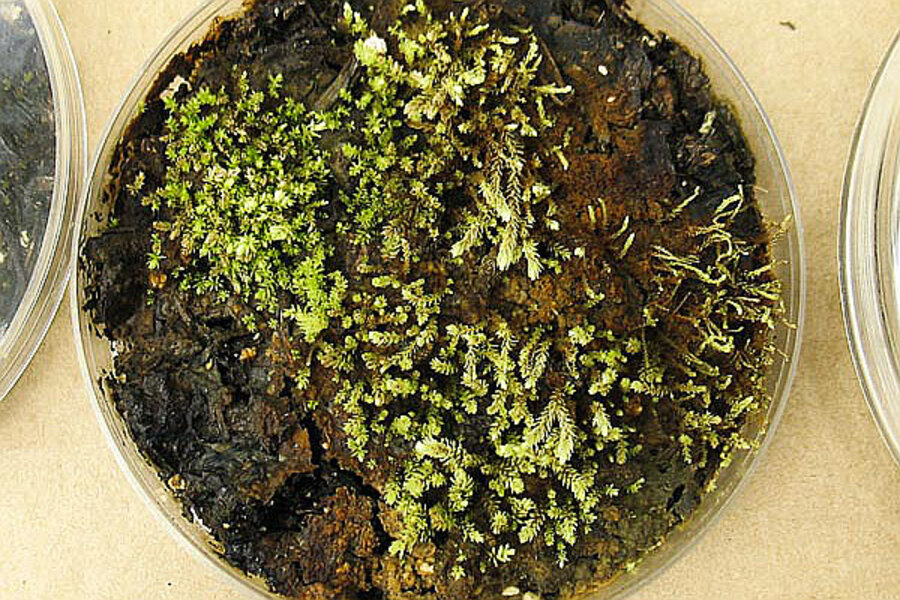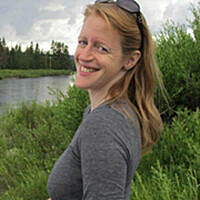Zombie plants? Frozen plants thaw and wake up from 400-year nap
Loading...
It's like something out of a zombie movie, or at least Encino Man: What was dead and frozen for hundreds of years suddenly sits up, shakes its head a few times, and goes about its business.
But this is real, and happening with mosses in Greenland. Once buried under thousands of tons of glacial ice, these mosses are green and growing again.
And not just one or two feisty stragglers: Dr. Catherine La Farge and colleagues from the University of Alberta found between 60 and 144 different species of moss that are spontaneously regrowing after centuries on ice.
Glaciers on Ellesmere Island, off the coast of Greenland, are rapidly retreating, like most glaciers around the world. As they pull back, they are uncovering whole ecosystems of mosses that are starting to wake up and blink in the sunlight.
Scientists saw the newly exposed mosses just a few feet from the edge of Teardrop Glacier on Ellesmere, on land that had been covered by the glacier only a year before. Most of the mosses were black, says La Farge, but they were structurally intact, and some looked suspiciously green.
"As I looked more closely I thought, 'Oh my gosh, what's this? Either this has somehow managed to retain a vestige of its original color, or it's just started to grow again after centuries under the ice,'" she told National Geographic. "The thought of that just blew my mind."
Arctic explorers have noticed these glacial-edge mosses before, but always assumed that they were seeing modern mosses that had blown onto the "dead mats," like squatters moving into a long-abandoned building. But when Dr. La Farge's team put the moss under a microscope, they saw that the green branches were growing from 500-year-old stems.
They put blackened moss with potting soil under a grow lamp and held their breath. Six weeks later, they had proof: these ancient mosses, frozen since the Middle Ages, were growing again.
These plants froze between 404 and 615 years ago, according to radiocarbon dating, or between 1398 and 1609, during the early part of the "Little Ice Age" that chilled much of Europe. The last time they saw the sun, English speakers were using words like "verily" and "forsooth."
How is this possible?
Moss has a big advantage helping its resuscitation along: its cells can replicate themselves and grow into anything the plant needs. Mosses are essentially built of stem cells, cloning themselves endlessly, without stamens, pistils, or any of the other trappings of sexual reproduction. But while their cloning abilities are well known, no one expected that they'd be able to grow again – spontaneously, without help – after spending centuries trapped under thousands of feet of ice.
The successful resurrection of these newly exposed plants raises interesting questions about the role of mosses in periglacial ecosystems, where glaciers advance and retreat over and over again.
Though easily overlooked because of its unimposing stature, moss is vital to permafrost ecosystems – without it, animals from mice and rabbits to deer and caribou could starve in the frozen north, where few plants thrive.
At the poles and in mountains around the world, most glaciers are retreating faster than ever in recorded history. Will the newly exposed glacial terrain remain frozen and barren, or will these "zombie" mosses rebuild thriving ecosystems in some of the harshest terrain on the planet?
Glaciers beating a hasty retreat
Most glaciers have been shrinking for decades, but what used to be a slow saunter – moseying back a few feet each year – is now a sprint. Since 2007, arctic glaciers have retreated about 13 feet (4.1 m) each year, almost three times as fast as the retreat speed of the 1960s and 1970s. That might not sound like much, given the thousands of square miles these glaciers cover, but the rapid acceleration of the melt has caught the attention of scientists and policymakers.
The good news is that we're finding all sorts of fascinating things under the ice, from zombie mosses to still-bleeding mammoths.
The bad news is that when they these landlocked glaciers melt into the ocean, it raises ocean levels. Since about 10 percent of the world's population lives within a few feet of sea level, that's a lot of people contemplating a water-logged lifestyle.








